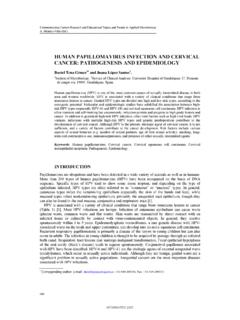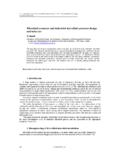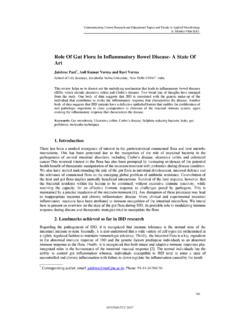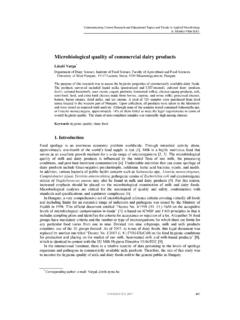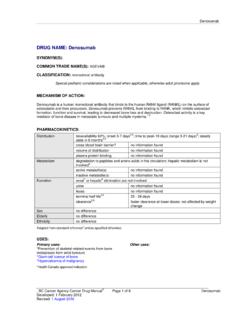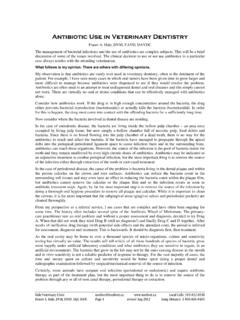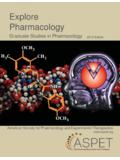Transcription of Non-Candida albicans Candida yeasts of the oral …
1 Non- Candida albicans Candida yeasts of the oral cavity Meurman1,2, E. Siikala1,3, M. Richardson3 and R. Rautemaa2,3,4 1 Institute of dentistry , University of Helsinki, Box 41, 00014 University of Helsinki, Helsinki Finland 2 Department of Oral and Maxillofacial Diseases, Helsinki University Central Hospital, Box 263, 00029 HUS Helsinki, Finland 3 Haartman Institute, Department of Bacteriology and Immunology, University of Helsinki, Box 21, 00014 University of Helsinki, Helsinki, Finland 4 HUSLAB Clinical Microbiology, Helsinki University Central Hospital, Box 263, 00029 HUS, Helsinki, Finland Candida species are prevalent in the oral cavity, in particular among elderly patients with reduced salivary flow and/or dental prostheses, and in immunosuppressed patients.
2 The most frequently encountered species are Candida albicans . Non- Candida albicans Candida (NCAC) strains, however, are isolated in increasing numbers in medically compromised patients. These strains may cause systemic infections and are often resistant to commonly used antifungal agents such as fluconazole. Candida species may be capable of metabolizing ethanol to carcinogenic acetaldehyde and can thus progress oral and upper gastrointestinal tract cancer. Consequently, more focus should be placed on diagnosis and treatment of oral Candida infections, also on other Candida species than C. albicans . This review outlines the current knowledge about the NCAC yeasts with emphasis on oral medicine.
3 Keywords Candida , oral cavity 1. Introduction yeasts are opportunistic pathogens and cause disease in hosts who are compromised by underlying local or systemic pathological processes [1]. Oral candidiasis is a sign of impaired local or systemic defense mechanisms. Reduced saliva secretion, deficiencies of humoral or cell-mediated immunity, local mucosal diseases and the use of wide-spectrum antibiotics are predisposing factors [2]. Candida is part of the oral normal flora in most people. In the newborn, colonization usually occurs from the mother s vaginal flora or other exogenous sources and it appears that most people are colonized with a distinct strain of Candida ; if infection occurs, the infecting strain is then the same strain as the colonizer [3].
4 Carriage rate for Candida is hard to give since it depends on the age and health of the population studied [4], but a range from 17% to 75% has been reported [5]. For example, in a comprehensive study of 75-year olds in Japan, Candida was detected in 67% of samples from the dorsum of the tongue and the prevalence was significantly associated with the presence of any dental prostheses, missing teeth, the number of retained roots and the percentage of periodontal pockets showing bleeding on probing. Dental prostheses particularly affected the number of Candida strains identified and the density of colonies in this study. In addition, the prevalence of multi-species carriage was linked with the presence of prostheses [6].
5 Systemic candidiasis in hospitalized and institutionalized patients has increased over the last decades [7, 8]. This is due to the increasing number of immunocompromised patients, immunosuppressive therapies and the elderly as well as the increased use of wide-spectrum antibiotics and indwelling intravascular devices [9]. Candida is the fourth most common cause of hospital-rated bloodstream infections in the [10, 11] but the mortality rate exceeds that of bacteremia [7]. Oral candidiasis is the most common human fungal infection [12]. Candida albicans is the most commonly isolated fungal 719 Communicating Current Research and Educational Topics and Trends in Applied Microbiology A.
6 M ndez-Vilas (Ed.)_____ FORMATEX 2007 pathogen in the oral cavity, but the number of isolated Candida species other than Candida albicans is increasing [7,13,14]. These species are often resistant to commonly used azole antifungal agents. 2. Candida species yeasts which are part of the genus Candida consist of 150-200 species [15]. They are imperfect unicellular dimorphic fungi which multiply mainly by budding similar cells from their surface and form hyphae and/or pseudohyphae [1]. They were earlier assigned to the family deuteromycetes, indicating a lack of sexual reproduction. However, several pathogenic and non-pathogenic Candida species have been identified to have a sexual stage [16].
7 Table 1 presents the principal Candida species according to current nomenclature. Figure 1 shows the morphology of some oral Candida species as seen in the scanning electron microscope. Candida albicans is the most common species isolated from the oral cavity in both healthy and diseased (in 60 - 80% of the cases) [2,17]. Other species responsible for oral infections have also been identified including C. glabrata, C. krusei, C. parapsilosis, C. dubliniensis, C. tropicalis, C. kefyr and C. guilliermondii [4,14,15,17]. Also species such as C. inconspicua, C. lusitaniae, C. norvegensis and C. rugosa have been isolated occasionally from patients [1].
8 yeasts not belonging to the genus Candida such as Rhodotorula glutinis and Saccharomyces cerevisae are sometimes found in the oral cavity but these are not known to cause oral infections [18]. However, colonization of Candida in the oral cavity does not indicate infection in the absence of clinical lesions or other symptoms. All the candidal species cause the same kind of mucositis but there are differences in the invasiveness and antifungal susceptibilities among species [2]. The role of these other species also referred to as non- albicans species have become increasingly important, especially in high-risk patients. Table 1 Principal Candida species.
9 Candida albicans Candida dubliniensis Candida famata Candida glabrata Candida guilliermondii Candida inconspicua Candida kefyr Candida krusei Candida lusitaniae Candida norvegensis Candida parapsilosis Candida rugosa Candida tropicalis 3. Pathogenic non- Candida albicans Candida (NCAC) species The NCAC species are a heterogenous group of organisms and different from each other and from C. albicans [19]. Earlier, it was considered that C. albicans was the only species causing infection and C. parapsilosis, C. tropicalis and C. guilliermondii were considered only as occasional pathogens [19]. The development of new medical therapies, treatments for cancer, the increase in invasive medical procedures, the emergence of human immunodefiency virus (HIV) and AIDS, and the wide-spread use of broad-spectrum antibiotics, however, lead to the increasing recovery of many other NCAC species causing mucosal infections [19].
10 The NCAC species are thought to cause candidiasis of less virulence explained by the fact that they lack, totally or partially, some virulence factors that the most virulent species C. albicans has. These are, for example, the ability to form hyphae and the ability to perform 720 Communicating Current Research and Educational Topics and Trends in Applied Microbiology A. M ndez-Vilas (Ed.)_____ FORMATEX 2007phenotypic switching. They may also have a lower adherence capability to buccal epithelial and vascular endothelial surfaces and lower secretion of proteinases [19]. Figure 1. Scanning electron microscopic images of some non- Candida albicans Candida strains.
